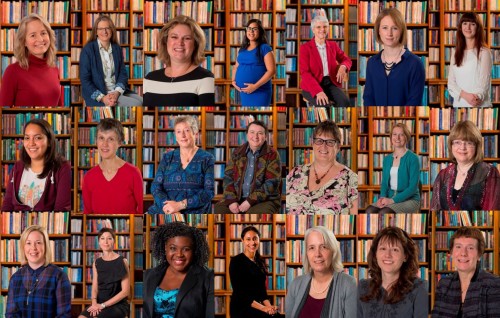By Hamish Johnston
The first documented female astronomer in Britain was Margaret Flamsteed (1670–1739), who worked with her husband John at the Royal Observatory in Greenwich. That’s according to astronomer Mandy Bailey of the UK’s Royal Astronomical Society, who has written an article entitled “Women and the RAS: 100 years of Fellowship”. As the title suggests, this year is the centenary of the first women becoming fellows of the RAS.
To celebrate the centenary, the RAS commissioned Maria Platt-Evans to photograph 21 leading female fellows. The portraits appear above and are also presented in the slide show “Women of the Royal Astronomical Society”, which includes short biographies.
In her article, Bailey describes how Mary Blagg, Ella Church, Grace Cook and Fiammetta Wilson came to be elected fellows on 14 January 1916. She also laments the fact that, 100 years later, “We now have many female fellows, but they do not make up half the membership.” There is more about the centenary celebrations at “100 years and counting: women in the RAS go from strength to strength“.
“Because science is beautiful” is the subtitle of a nice article on Gadgette about a UK-based company, “Uprosa’s gorgeous phone cases are made using real scientific images”. Founded by three graduates of the University of Cambridge, Uprosa turns real scientific images into stunning mobile-phone cases, bags and other objects. Images are provided by “real scientists” such as Adrianus Indrat Aria of the University of Cambridge, who studies graphene and has designed a phone case called Asteroidea Electrica based on an electron-microscopy image of free-standing graphene foam.

Golden oldie: the new incandescent light bulb. (Courtesy: MIT)
It’s becoming increasingly difficult to find old-fashioned incandescent light bulbs here in the UK, where LEDs tend to dominate the supermarket shelves. Incandescent bulbs are becoming increasingly rare because they tend to waste about 97% of their input energy by producing lots of heat as well as light.
Now, a team of physicists at the Massachusetts Institute of Technology and Purdue University in the US have invented a new type of light bulb (right) that converts some of this wasted energy into useful light. The bulb comprises a traditional incandescent filament that creates light and lots of heat in the form of infrared radiation. The filament is surrounded by a photonic-crystal material that is transparent to visible light but reflects the infrared heat back towards the filament – thereby heating it and creating light. The team’s device achieved a modest 6.6% energy efficiency, which is about double that of an incandescent bulb but pales in comparison with the best LED bulbs that can achieve 20%. However, the team thinks it could boost the efficiency of its incandescent device to 40%. So we shouldn’t give up on the old-fashioned light bulb just yet.

It would be nice, if one can boost the efficiency of the “composed incandescent” lamp to 40 %, but it is going to be huge task in the distant future, if at all. However, as we see every day around us, the LED’s have some unique properties that even a composed incandescent lamp will not have.